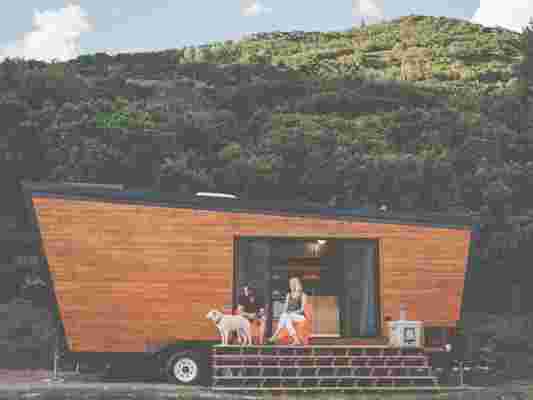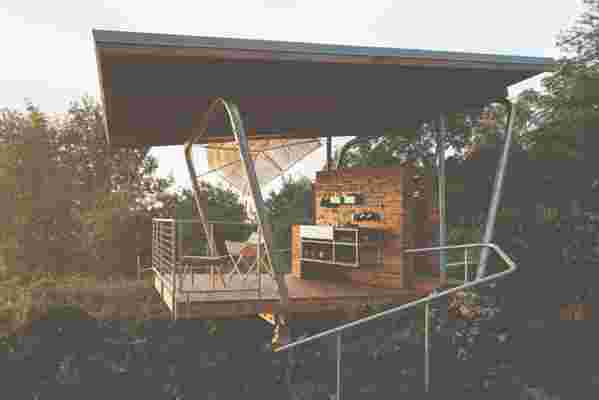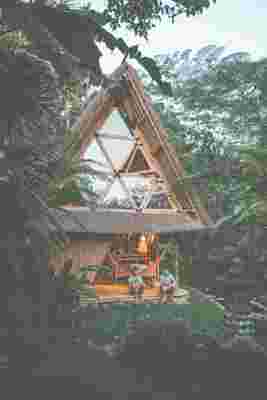While most people have fallen for tiny houses in the past few years, Brent Heavener has been fascinated with the small dwellings for decades, dating back to his teenage years. “When I was 16 my dad sent me a picture of a shipping container that had been transformed into a fully functional tiny home,” he says. “I was sold. These small, unique, inspiring spaces fed my love for simple craftsmanship and sovereign living. I was fueled by the freedom and sense of boundless creativity tiny homes sparked within me.” Heavener’s family also lived in an eclectic mix of spaces during his childhood, from a condemned 1900s home in the California high desert to an abandoned Baptist church. “The one thing that all our homes and ventures had in common was freedom,” he says. “It’s that same desire for freedom that stirs action towards a solution offering financial freedom, the freedom to live sustainably, freedom to travel, and, overall, the freedom to live in simplicity.”
His passion for tiny houses, and the independence they offer, led him to start @tinyhouse, which has grown into the biggest tiny house account on Instagram, with 726,000 followers (as of September 2019). He’s now gone from the ’gram to the printed page with his new book Tiny House (Clarkson Potter, $18). The volume showcases tiny homes around the world, from a houseboat in Australia to a treehouse in Toronto to campers on the open roads of North America. “I had a mental ‘board’ of homes that I’d come to love over the years of being involved in the tiny house movement and coming across so many homes.” he says. “I knew I wanted to include those.” Naturally, he also turned to Instagram to find projects to include, searching for viral hits as well as lesser-known spaces. Each space had to be functional and inspirational. “Design was at the forefront of my criteria list when bringing a home within the book for the readers to delve into,” Heavener explains. “With the turn of each page, I want these homes to instill inspiration and ideas for their next project, whether it be a remodel within their current home, a backyard garden shed, or building their own tiny house.” See below for a peek into some of the amazing spaces in Tiny House.

“Brian and Joni Buzarde’s “Woody” tiny house blew me away,” says Heavener of this mobile dwelling in California. “Not only the stunning design of their house, but the way they did it as well. The preconceived notion—and rightfully so—is that you’ve got to have prior major construction or carpentry experience to bring your tiny-house-living dream to life. It’s definitely a plus when self-building a home, but Brian and Joni are a testament to the fact that you can create a functional, beautifully designed tiny home with no prior major building experience.”

Outside House consists of a small cabin and an open pavilion with an outdoor kitchen and shower. “This is one of the most unique homes featured in the book—mainly because each part of the home is built separately into different structures,” says Heavener. “The home is built on a tropical and lush location in Hawaii, with the kitchen and bathroom taking on a modern, sleek style, and the bedroom a short walk away with the same exquisite look. One of the ideas that I want to portray in the book is that you can’t box a tiny home in. It can come in all sorts of shapes, styles, designs, and even sizes. The Outside House exemplifies that fact that you can create a tiny home that serves you and is built around your life, even if it’s different. That’s the beauty of tiny living.”

The Hideout in Bali is an eco-friendly structure crafted of bamboo. The two-story space is tucked away in the mountains around the Gunung Agung volcano and can be rented on Airbnb .
AD100 architecture firm Olson Kundig’s “Rolling Hut” is set in the mountains of Mazama, Washington. “The home has a simplistic, minimal design, yet is subtlely bold,” he says. “One of the aspects that I love about this home is that it proves the creatives opportunities are endless when it comes to the resources you can use to build a home with. The designers decided to go with an industrial steel frame, housing a light, clean plywood interior.”
“Nolla” is an A-frame house on Vallisaari Island, near Helsinki, Finland. The low-impact home was designed by Robin Falck, who created a minimalist, sustainable space that uses the surrounding landscape as the focal point.
